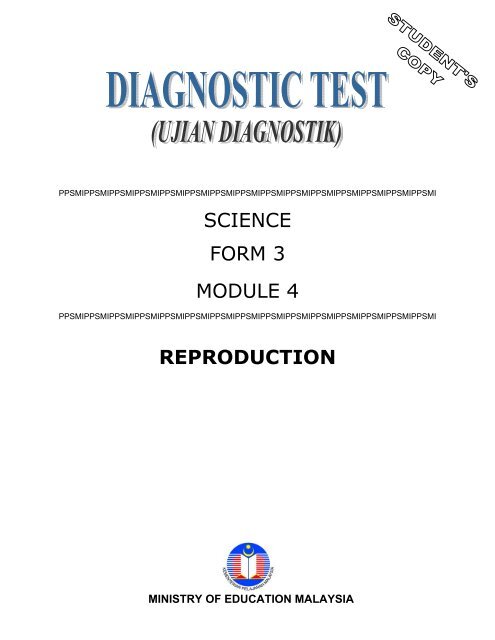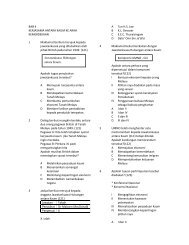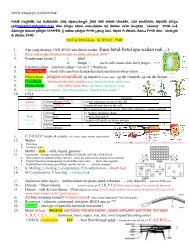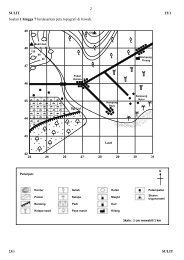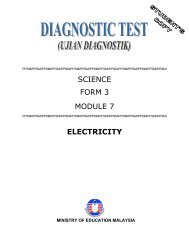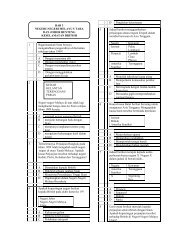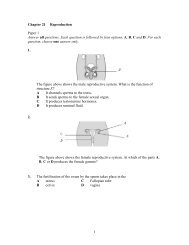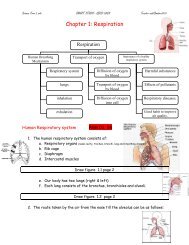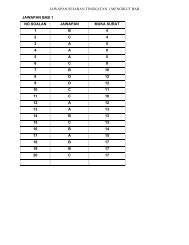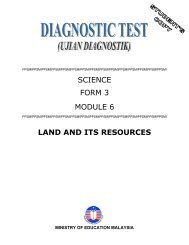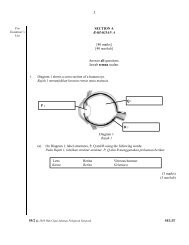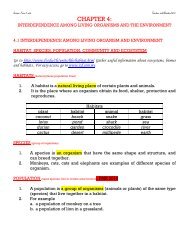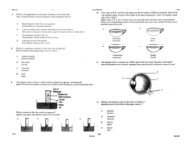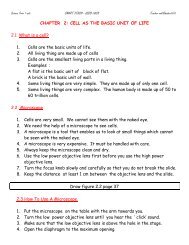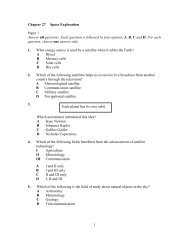SCIENCE FORM 3 MODULE 4 REPRODUCTION
SCIENCE FORM 3 MODULE 4 REPRODUCTION
SCIENCE FORM 3 MODULE 4 REPRODUCTION
Create successful ePaper yourself
Turn your PDF publications into a flip-book with our unique Google optimized e-Paper software.
PPSMIPPSMIPPSMIPPSMIPPSMIPPSMIPPSMIPPSMIPPSMIPPSMIPPSMIPPSMIPPSMIPPSMIPPSMI<br />
<strong>SCIENCE</strong><br />
<strong>FORM</strong> 3<br />
<strong>MODULE</strong> 4<br />
PPSMIPPSMIPPSMIPPSMIPPSMIPPSMIPPSMIPPSMIPPSMIPPSMIPPSMIPPSMIPPSMIPPSMIPPSMI<br />
<strong>REPRODUCTION</strong><br />
MINISTRY OF EDUCATION MALAYSIA<br />
1
<strong>MODULE</strong> 4: <strong>REPRODUCTION</strong><br />
Arahan:<br />
1. Modul ini mengandungi empat puluh tiga soalan. Semua soalan adalah dalam<br />
bahasa Inggeris.<br />
2. Modul merangkumi enam konstruk yang diuji<br />
K1-Memahami soalan dalam Bahasa Inggeris<br />
K3-Memahami istilah sains dalam Bahasa Inggeris<br />
K5-Menguasai konstruk pengetahuan<br />
K6-Menguasai konstruk kefahaman<br />
K7-Menguasai konstruk kemahiran<br />
K10-Memahami pengajaran dan pembelajaran dalam Bahasa Inggeris<br />
3. Murid hendaklah menulis maklumat diri dalam kertas jawapan objektif<br />
disediakan. Murid juga perlu memastikan maklumat konstruk, nombor soalan dan<br />
jumlah soalan seperti yang dibaca oleh guru di dalam ruangan disediakan dalam<br />
kertas jawapan objektif sebelum ujian.<br />
4. Bagi soalan objektif, anda perlu menandakan jawapan dengan menghitamkan<br />
pilihan jawapan pada pilihan jawapan A , B , C atau D pada kertas jawapan<br />
objektif.<br />
Contoh:<br />
Antara berikut, yang manakah haiwan<br />
A. Pokok B. Kambing C. Kereta D. Pen<br />
A B C D<br />
E<br />
5. Bagi soalan 36 hingga 43, soalan dikemukakan secara lisan oleh guru<br />
manakala jawapan diberi secara bertulis oleh pelajar.<br />
6. Jawab semua soalan.<br />
Modul ini mengandungi 22 halaman bercetak<br />
2
1. The figure shows the types of reproduction in living organism<br />
asexual<br />
Reproduction<br />
sexual<br />
How many ways can a living organism reproduce<br />
A 1<br />
B 2<br />
C 3<br />
2. The figure shows a regular menstrual cycle<br />
Bleeding<br />
begins<br />
Menstruation<br />
Fertile<br />
phase<br />
How long is the menstrual cycle<br />
A<br />
B<br />
C<br />
D<br />
7 days<br />
11 days<br />
17 days<br />
28 days
3. The figure shows types of pollinations in flowering plants<br />
Cross pollination<br />
Self pollination<br />
How many type(s) of pollinations are there in the figure<br />
A 1<br />
B 2<br />
C 3<br />
D 4<br />
4. The suitable temperature for a seed to germinate is around 28 o C.<br />
What is the range of temperature ( o C ) for a seed to germinate<br />
A 0 – 5<br />
B 20 – 35<br />
C 60 – 70<br />
4
5. A flowering plant can reproduce vegetatively using its various parts such as<br />
runners, rhizomes, tuber, sucker, bulb and leaf.<br />
Which of the following is not a vegetative part of flowering plant<br />
A<br />
B<br />
C<br />
D<br />
Leaf<br />
Sucker<br />
Runner<br />
Flower<br />
6. The process in which unicellular organism divides and separates into two equal<br />
sizes is known as _____________ .<br />
A<br />
B<br />
C<br />
D<br />
budding<br />
binary fission<br />
spore formation<br />
regeneration<br />
7. The figure shows a menstrual cycle.<br />
Day<br />
1 2 3 4 5 6 7 8 9 10 11 12 13 14 15 16 17 18 19 20 21 22 23 24 25 26 27 28<br />
Menstruation<br />
phase<br />
Fertile<br />
phase<br />
The process when an ovary produces an ovum during the fertile phase is known<br />
as ________________.<br />
A<br />
B<br />
C<br />
ovulation<br />
fertilisation<br />
pollination<br />
5
8. The figure shows the process of _____________<br />
sperm<br />
ovum<br />
A<br />
B<br />
C<br />
D<br />
ovulation<br />
fertilisation<br />
menstruation<br />
germination<br />
9. The figure shows the process of _____________ .<br />
Pollen<br />
grain<br />
Plant A<br />
Plant B<br />
A<br />
B<br />
C<br />
self-pollination<br />
cross-pollination<br />
germination<br />
6
10. The figure shows stages where a seed develops into a seedling.<br />
The process is known as _____________ .<br />
A<br />
B<br />
C<br />
pollination<br />
fertilization<br />
germination<br />
11. Reproduction of a new plant from a certain part of the plant is known as ______.<br />
A<br />
B<br />
C<br />
binary fission<br />
spores formation<br />
vegetative reproduction<br />
12. Which of these reproductive processes are asexual reproductions<br />
I<br />
II<br />
III<br />
Budding<br />
Regeneration<br />
Rhizome<br />
A<br />
B<br />
C<br />
D<br />
I and II<br />
I and III<br />
II and III<br />
I, II and III<br />
7
13. The figure shows a female reproductive system.<br />
P<br />
What is the function of P<br />
A<br />
B<br />
C<br />
D<br />
The place where fertilization occurs<br />
To control the sex hormones<br />
To produce the female sex gametes<br />
To remove excess sperms that enter the body<br />
14. Which part of the female reproductive system is involved during the delivery of a<br />
baby<br />
A<br />
B<br />
C<br />
cervix<br />
ovary<br />
fallopian tube<br />
15. The female and male gametes of flowering plants are located at the _________.<br />
A<br />
B<br />
C<br />
D<br />
sepal and stamen<br />
pistil and ovary<br />
ovule and pollen grain<br />
filament and anther<br />
8
16. Which of the following develops from an ovary after fertilisation<br />
A<br />
B<br />
C<br />
D<br />
Spore<br />
Seed<br />
Fruit<br />
Gamete<br />
17. Which parts of the seed will grow during germination<br />
I<br />
II<br />
III<br />
IV<br />
A<br />
B<br />
C<br />
D<br />
Testa<br />
Plumule<br />
Cotyledon<br />
Radicle<br />
I and II<br />
I and III<br />
II and III<br />
II and IV<br />
18. Female infertility is caused by<br />
A<br />
B<br />
C<br />
D<br />
impotence<br />
low sperm count<br />
blocked fallopian tube<br />
penis unable to ejaculate sperms<br />
19. Which of the following birth control is not a mechanical method<br />
A<br />
B<br />
C<br />
D<br />
Ligation<br />
Condom<br />
IUD<br />
Diaphragm<br />
9
20. Which of the following birth control methods is used by males<br />
A<br />
B<br />
C<br />
D<br />
IUD<br />
Vasectomy<br />
Spermicides<br />
Contraceptive pills<br />
21. The figure shows the process of pollination<br />
S<br />
P<br />
R<br />
Q<br />
Where does the transfer of pollen grain take place<br />
A<br />
B<br />
C<br />
D<br />
PR<br />
PQ<br />
SP<br />
SQ<br />
22. Cross-pollination is better than self pollination because the offspring _________ .<br />
I<br />
II<br />
III<br />
produces more fruits<br />
survives better under bad weather<br />
is less resistant to diseases<br />
A<br />
B<br />
C<br />
D<br />
I and II<br />
I and III<br />
II and III<br />
I, II and III<br />
10
23. The figure shows the male reproductive organ.<br />
P<br />
.<br />
What happen if the structure P does not function The man is unable to _______<br />
A regulate his body temperature<br />
B produce seminal fluid<br />
C delivers sperms into the vagina<br />
D produce sperms and the male sex hormones<br />
11
24. The figure shows a process which occurs in the female reproduction system<br />
during fertilisation.<br />
Q<br />
R<br />
P<br />
S<br />
Reproduction system<br />
Fertilisation process<br />
In which part does this process take place<br />
A<br />
B<br />
C<br />
D<br />
P<br />
Q<br />
R<br />
S<br />
12
25. The figure shows a flowering plant.<br />
Which of the following is the pollinating agent for this plant<br />
A<br />
B<br />
C<br />
D<br />
Insect<br />
Bird<br />
Wind<br />
Water<br />
13
26. The figure shows a test tube containing seed kept in a refrigerator.<br />
wet cotton<br />
seed<br />
The seed did not germinate after four days because there is an absence of<br />
____________ .<br />
A A sunlight<br />
B B air<br />
C C water<br />
D D warmth<br />
14
27. The figure shows an experiment to study the conditions needed for germination<br />
of seeds.<br />
oil<br />
Boiled<br />
water<br />
Tap<br />
water<br />
Dry<br />
cotton<br />
Wet<br />
cotton<br />
P Q R S<br />
Which of the following show the germination of seeds after five days<br />
A<br />
B<br />
C<br />
D<br />
P and Q<br />
Q and S<br />
S and R<br />
R and S<br />
28. The figure shows characteristics of plants<br />
Plant P<br />
• Big and<br />
colourful<br />
flower<br />
• Produces<br />
nectar<br />
Plant Q<br />
• Produces<br />
large quantity<br />
of pollen<br />
grains<br />
• Does not<br />
produces<br />
nectar<br />
Plant R<br />
• Produces<br />
small quantity<br />
of pollen<br />
grains<br />
• Short filament<br />
and small<br />
anther<br />
Which plant is pollinated by animals<br />
A<br />
B<br />
C<br />
Plant P and plant Q<br />
Plant P and plant R<br />
Plant Q and plant R<br />
15
29. The figure shows a male reproductive system.<br />
S<br />
Q<br />
P<br />
R<br />
Choose the correct pathway to release the sperm.<br />
A<br />
B<br />
C<br />
D<br />
P Q R<br />
Q P S<br />
R S Q<br />
S R P<br />
30. The figure shows the calendar for March 2008<br />
MARCH 2008<br />
S M T W T F S<br />
1 2 3<br />
4 5 6 7 8 9 10<br />
11 12 13 14 15 16 17<br />
18 19 20 21 22 23 24<br />
25 26 27 28 29 30 31<br />
Aminah has her first day of menstruation on the 6 th of March. When is her next<br />
menstruation<br />
A 1 April 2008<br />
B 2 April 2008<br />
C 3 April 2008<br />
D 4 April 2008<br />
16
31. The figure shows an experiment to study the conditions for seeds to germinate.<br />
Wet<br />
cotton<br />
Wet<br />
cotton<br />
0 o C 15 o C 30 o C 70 o C<br />
What is the manipulated variable for this experiment<br />
A<br />
B<br />
C<br />
Temperature<br />
Oxygen<br />
Water<br />
32. The table shows the different conditions in the test tube P, Q, R and S that are<br />
used to study the factors that affect the seeds germination.<br />
After 5 days, in which of the test tubes will the seed germinate<br />
Test tube Temperature Oxygen Water<br />
A P 27 o C present absent<br />
B Q 27 o C present present<br />
C R 5 o C present absent<br />
D S 5 o C present present<br />
17
33 The figure shows the parts of plant that can reproduce vegetatively.<br />
Shallot<br />
Bryophyllum<br />
Banana plant<br />
Potato<br />
Ginger<br />
Yam<br />
Which of the following is correct<br />
Root<br />
Stem<br />
A Potato Banana plant<br />
B Bryophyllum Yam<br />
C Banana plant Ginger<br />
D Shallot Yam<br />
18
34. The figure shows the germination of a seed<br />
P Q R S<br />
Choose the correct stages in the germination of seed.<br />
A<br />
B<br />
C<br />
D<br />
PQRS<br />
PRQS<br />
QRSP<br />
QSRP<br />
19
35. The figure shows the flowers of flowering plants<br />
P: sunflower Q: corn R: hibiscus S: water lily<br />
Which flowers are pollinated by insects<br />
A<br />
B<br />
C<br />
D<br />
P and Q<br />
Q and R<br />
R and S<br />
P and R<br />
36. Drugs, alcohol and tobacco smoke are known as<br />
A<br />
B<br />
C<br />
D<br />
miscarriage<br />
birth defects<br />
mental retardation<br />
harmful substances<br />
37. Give one way to overcome sterility<br />
A<br />
B<br />
C<br />
D<br />
Natural family planning<br />
Birth control pills<br />
Barrier method such as condom<br />
Hormone treatments<br />
20
38. Name two types of reproduction.<br />
A<br />
B<br />
C<br />
D<br />
Budding and asexual<br />
Spore formation and binary fission<br />
Regeneration and asexual<br />
Asexual and sexual<br />
39. A flowering plant can reproduce vegetatively by using its _________<br />
I root<br />
II stem<br />
III fruit<br />
IV leaf<br />
A<br />
B<br />
C<br />
D<br />
I and II<br />
I and III<br />
I, II and III<br />
I, II and IV<br />
40. How many time(s) does ovulation occur in a month<br />
A 1<br />
B 2<br />
C 3<br />
D 4<br />
21
41. Name the human sexual organs.<br />
I<br />
II<br />
III<br />
IV<br />
Penis<br />
Sperm<br />
Ovary<br />
Ovum<br />
A<br />
B<br />
C<br />
D<br />
I and II<br />
I and III<br />
II and III<br />
II and IV<br />
42. A male reproductive organ of flower consists of _______________ .<br />
A<br />
B<br />
C<br />
D<br />
filament, anther and ovary<br />
stigma, style and ovary<br />
filament and anther<br />
stigma, style and anther<br />
43. The environmental factors needed by the seeds to germinate are ____________.<br />
I<br />
II<br />
III<br />
IV<br />
water<br />
light<br />
oxygen<br />
temperature<br />
A<br />
B<br />
C<br />
D<br />
I and II<br />
I and III<br />
I, II and III<br />
I, III and IV<br />
22
KEMENTERIAN PELAJARAN MALAYSIA<br />
KERTAS JAWAPAN OBJEKTIF<br />
Ujian Diagnostik<br />
Nama Pelajar:<br />
Tahun/ Tingkatan : 3 Mata Pelajaran: SAINS<br />
Nama Sekolah: Modul: 4<br />
GUNAKAN PENSIL 2B ATAU BB SAHAJA.<br />
TENTUKAN TIAP-TIAP TANDA ITU HITAM DAN MEMENUHI KESELURUHAN RUANG.<br />
PADAMKAN HINGGA HABIS MANA-MANA TANDA YANG ANDA UBAH<br />
SILA HITAMKAN JAWAPAN DI BAWAH MENGIKUT HURUF JAWAPAN YANG ANDA PILIH<br />
1<br />
2<br />
A B C D E<br />
A B C D E<br />
31<br />
32<br />
A B C D E<br />
A B C D E<br />
46<br />
47<br />
A B C D E<br />
A B C D E<br />
3<br />
4<br />
A B C D E<br />
A B C D E<br />
33<br />
34<br />
A B C D E<br />
A B C D E<br />
48<br />
49<br />
A B C D E<br />
A B C D E<br />
5<br />
A B C D E<br />
35<br />
A B C D E<br />
50<br />
A B C D E<br />
6<br />
7<br />
A B C D E<br />
A B C D E<br />
36<br />
37<br />
A B C D E<br />
A B C D E<br />
51<br />
52<br />
A B C D E<br />
A B C D E<br />
8<br />
9<br />
A B C D E<br />
A B C D E<br />
38<br />
39<br />
A B C D E<br />
A B C D E<br />
53<br />
54<br />
A B C D E<br />
A B C D E<br />
10<br />
A B C D E<br />
40<br />
A B C D E<br />
55<br />
A B C D E<br />
11<br />
12<br />
A B C D E<br />
A B C D E<br />
41<br />
42<br />
A B C D E<br />
A B C D E<br />
56<br />
57<br />
A B C D E<br />
A B C D E<br />
13<br />
14<br />
15<br />
A B C D E<br />
A B C D E<br />
A B C D E<br />
43<br />
44<br />
45<br />
A B C D E<br />
A B C D E<br />
A B C D E<br />
58<br />
59<br />
60<br />
A B C D E<br />
A B C D E<br />
A B C D E<br />
16<br />
17<br />
A B C D E<br />
A B C D E<br />
Konstruk No. Soalan Jumlah<br />
Soalan<br />
Bilangan Soalan<br />
Gagal Dijawab<br />
Kegunaan Guru<br />
18<br />
19<br />
20<br />
A B C D E<br />
A B C D E<br />
A B C D E<br />
1<br />
2<br />
K1<br />
K3<br />
1-5<br />
6-11<br />
5<br />
6<br />
21<br />
22<br />
A B C D E<br />
A B C D E<br />
3<br />
4<br />
K5<br />
K6<br />
12-22<br />
23-28<br />
11<br />
6<br />
23<br />
24<br />
25<br />
A B C D E<br />
A B C D E<br />
A B C D E<br />
5<br />
6<br />
K7<br />
K10<br />
29-35<br />
36 - 43<br />
7<br />
8<br />
26<br />
A B C D E<br />
7<br />
27<br />
28<br />
29<br />
A B C D E<br />
A B C D E<br />
A B C D E<br />
8<br />
9<br />
30<br />
A B C D E<br />
10<br />
23


